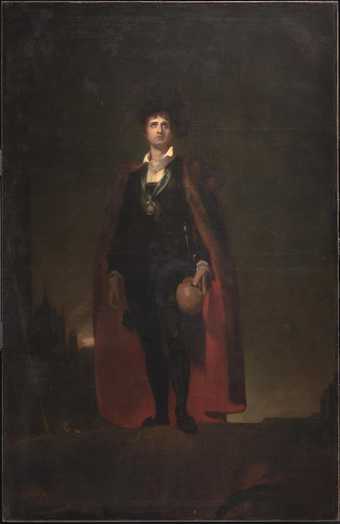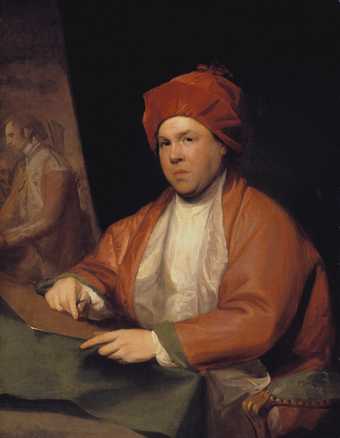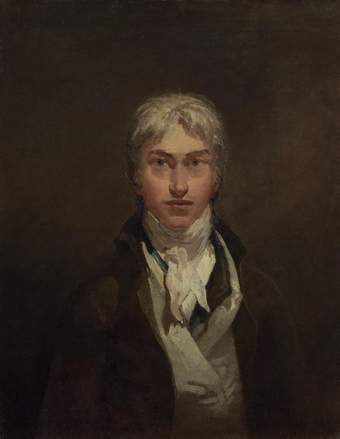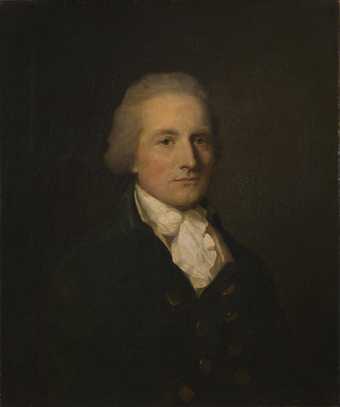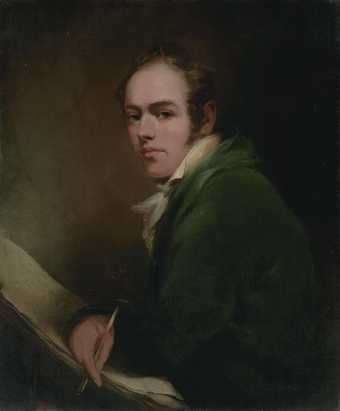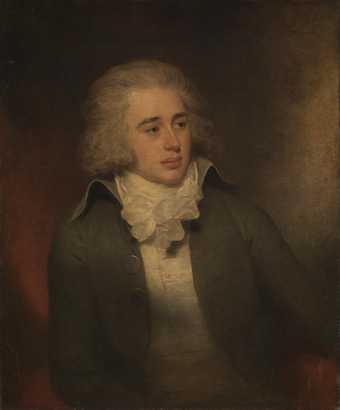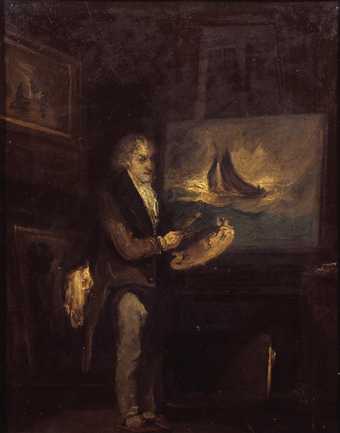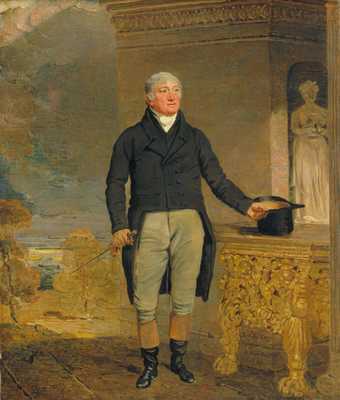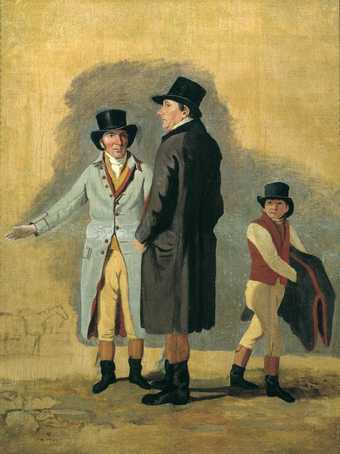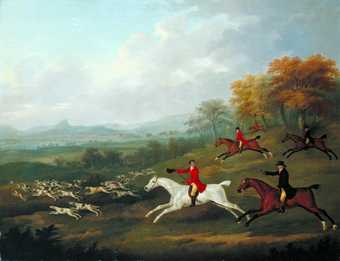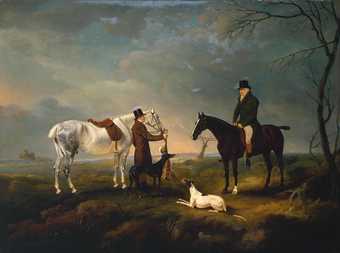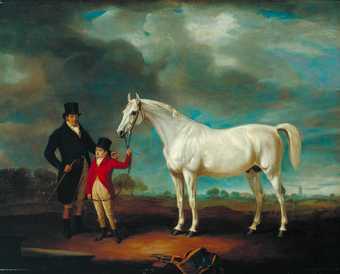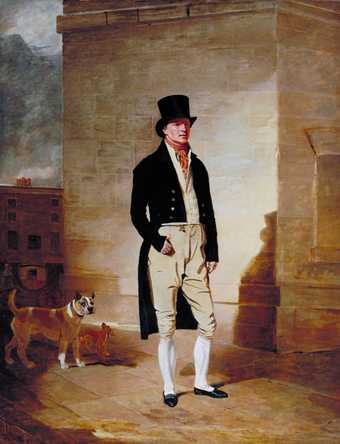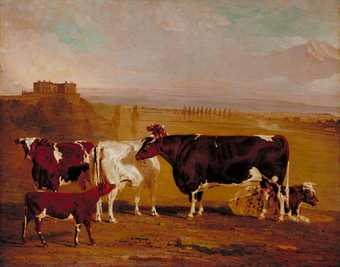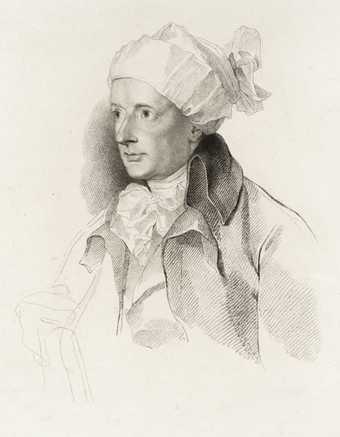
On loan
Gainsborough’s House (Sudbury, UK): Long loan to Gainsborough's House
- Artist
- Lemuel Francis Abbott 1760–1803
- Medium
- Oil paint on canvas
- Dimensions
- Support: 756 × 676 mm
frame: 915 × 790 × 70 mm - Collection
- Tate
- Acquisition
- Presented by Mrs M. Bernard 1968
- Reference
- T01067
Summary
This highly romanticised portrait depicts the distinguished Italian engraver, Francesco Bartolozzi (1727-1815). In his right hand Bartolozzi holds up an engraving tool, whilst directing his gaze towards the painting which he is presumably copying.
During his lifetime Francesco Bartolozzi enjoyed an international reputation as one of Europe’s finest line and stipple engravers. Born in Florence in 1727, Bartolozzi trained first as a goldsmith with his father, before entering the Florentine art academy. In 1745 he moved to Venice, where he was employed by the engraver and print-seller Joseph Wagner (1706-80). Here he engraved works by contemporary Italian painters as well as by the Old Masters, notably Guercino (1591-1666). Bartolozzi’s engravings after Guercino, which were greatly admired, prompted an invitation to England in 1764 to engrave drawings by that artist in the Royal Collection. In 1768 Bartolozzi was elected a founder member of the Royal Academy. In England Bartolozzi increasingly specialised in stipple engraving, a technique that involved building up an image with thousands of tiny dots to produce a smooth, soft focussed image. His preferred subjects were mythologies and female allegorical figures, often based on the work of Italian Old Masters, as well as contemporary London artists such as of Angelica Kauffman (1741-1807), Sir Joshua Reynolds (1723-92), and his close friend and compatriot, Giovanni Battista Cipriani (1727-1785).
By the time Abbott painted the present portrait, probably sometime between the late 1780s and the mid 1790s, Bartolozzi ran a large studio with up to fifty pupils and assistants. As well as history paintings and literary subjects, his professional life was by now engrossed by prints after contemporary British portrait painters, including Richard Cosway (1742-1821), George Romney (1734-1802), and Thomas Gainsborough (1727-88). Gainsborough, who had a high opinion of Bartolozzi’s skill as an engraver, was also keenly aware of his reputation as a womaniser. As he remarked memorably in a letter of 1787: ‘Why will Bartolozzi ... spend his last precious moments f_____g a young Woman, instead of out doing all the World with a Graver; when perhaps all the World can out do Him at the former Work?’ (John Hayes, ed., The Letters of Thomas Gainsborough, New Haven and London 2001, p.168).
Bartolozzi continued to work in London until 1802, when, at the age of seventy-five, he moved to Lisbon, where he became the director of the Academia de Belas Artes. Although no engravings from his time in Portugal are known, his signed prints continued to be published in London.
The painter of the present portrait, Lemuel Francis Abbott, was born in Leicestershire around 1760, although the exact date of his birth is unknown. The son of a clergyman, Abbott apparently received some artistic training under Francis Hayman (c. 1708-76), who, must himself have been well into his sixties by this time. Abbott was working in London by 1784. He exhibited portraits briefly at the Royal Academy between 1788 and 1789. His known portraits, of which that of Admiral Lord Nelson is the most celebrated, are all of men. Aside from Bartolozzi, they include a number of other artists, notably the engraver Valentine Green (1739-1813) and the sculptor, Joseph Nollekens (1737-1823), whom he painted around 1793 posed beside his own celebrated bust of the politician, Charles James Fox (London, National Portrait Gallery). In 1791 Abbott took on Ben Marshall (1767-1835) as his apprentice, although Marshall subsequently made his name as a sporting artist rather than a portraitist. During the later 1790s Abbott’s mental health deteriorated and, in 1798, he was formally declared insane. Even so, a number of works by him were exhibited at the Royal Academy that year and again in 1800.
Further reading:
A.C. Sewter, ‘Some new facts about Lemuel Francis Abbott’,
Connoisseur, April 1955, pp.178-83
Martin Postle
June 2001
Does this text contain inaccurate information or language that you feel we should improve or change? We would like to hear from you.
Display caption
Gallery label, September 2004
Does this text contain inaccurate information or language that you feel we should improve or change? We would like to hear from you.
Catalogue entry
Lemuel Francis Abbott 1760–1803
T01067 PORTRAIT OF THE ENGRAVER FRANCESCO BARTOLOZZI
Not inscribed.
Canvas, 29 3/4×26 5/8 (80·5×67·5)
Presented by Mrs M Bernard 1968.
Coll:
Mrs M Bernard.
Probably painted towards the end of Bartolozzi's stay in England. He left for Lisbon in 1802 and died there in 1815 at the age of 88. In Abbott's portrait he appears considerably older than in Marcuard's engraving of 1784 after Reynolds' portrait, for which Bartolozzi sat in 1771 and 1773.
Published in:
The Tate Gallery: Acquisitions 1968-9, London 1969
Explore
- leisure and pastimes(3,435)
-
- art and craft(2,383)
-
- drawing(221)
- printmaking(203)
- clothing and personal items(5,879)
-
- cravat(29)
- individuals: male(1,841)
- arts and entertainment(7,210)
-
- artist, printmaker(610)
You might like
-
Sir Thomas Lawrence John Philip Kemble as Hamlet
1801 -
Gilbert Stuart William Woollett the Engraver
exhibited 1783 -
Joseph Mallord William Turner Self-Portrait
c.1799 -
Lemuel Francis Abbott Henry Byne, of Carshalton
date not known -
Sir Francis Legatt Chantrey Self-Portrait
c.1810 -
Sir William Beechey James P. Johnstone
date not known -
John Thomas Smith Portrait of J.M.W. Turner, R.A.
date not known -
Benjamin Marshall The Rev. Edward Cage
1826 -
Benjamin Marshall Sir Charles Bunbury with Cox, his Trainer, and a Stable-Lad: A Study for ‘Surprise and Eleanor’
?1801 -
John Nost Sartorius The Earl of Darlington Fox-Hunting with the Raby Pack: Full Cry
1804 -
John Ferneley I Sir Robert Leighton after Coursing, with a Groom and a Couple of Greyhounds
1816 -
John Ferneley I Mr Powell and his Son, with Norton, a Grey Hunter
1816 -
Benjamin Marshall James Belcher, Bare-Knuckle Champion of England
?1803 -
After Sir Thomas Lawrence Portrait of William Cowper, engraved by Francesco Bartolozzi
1799

